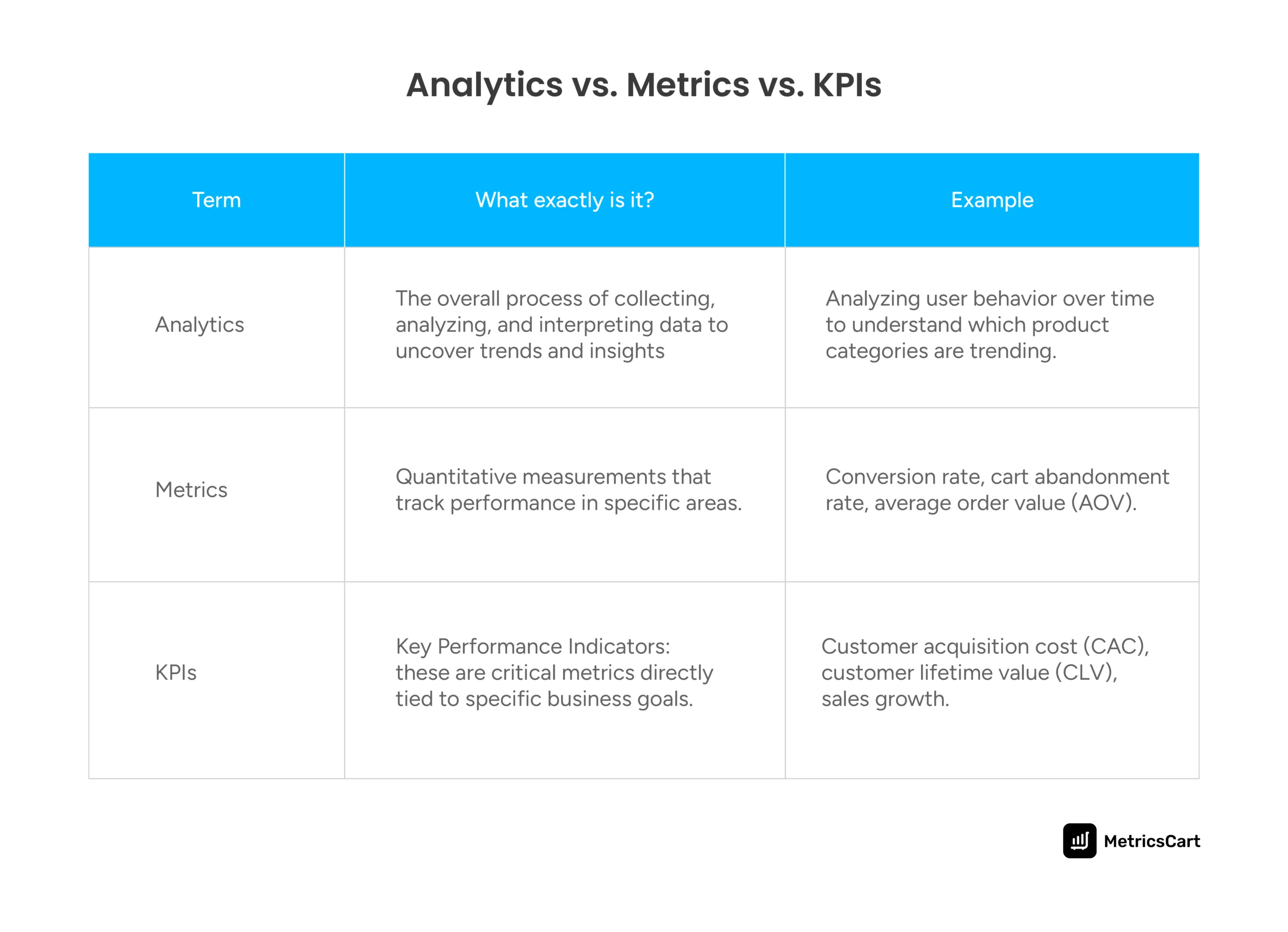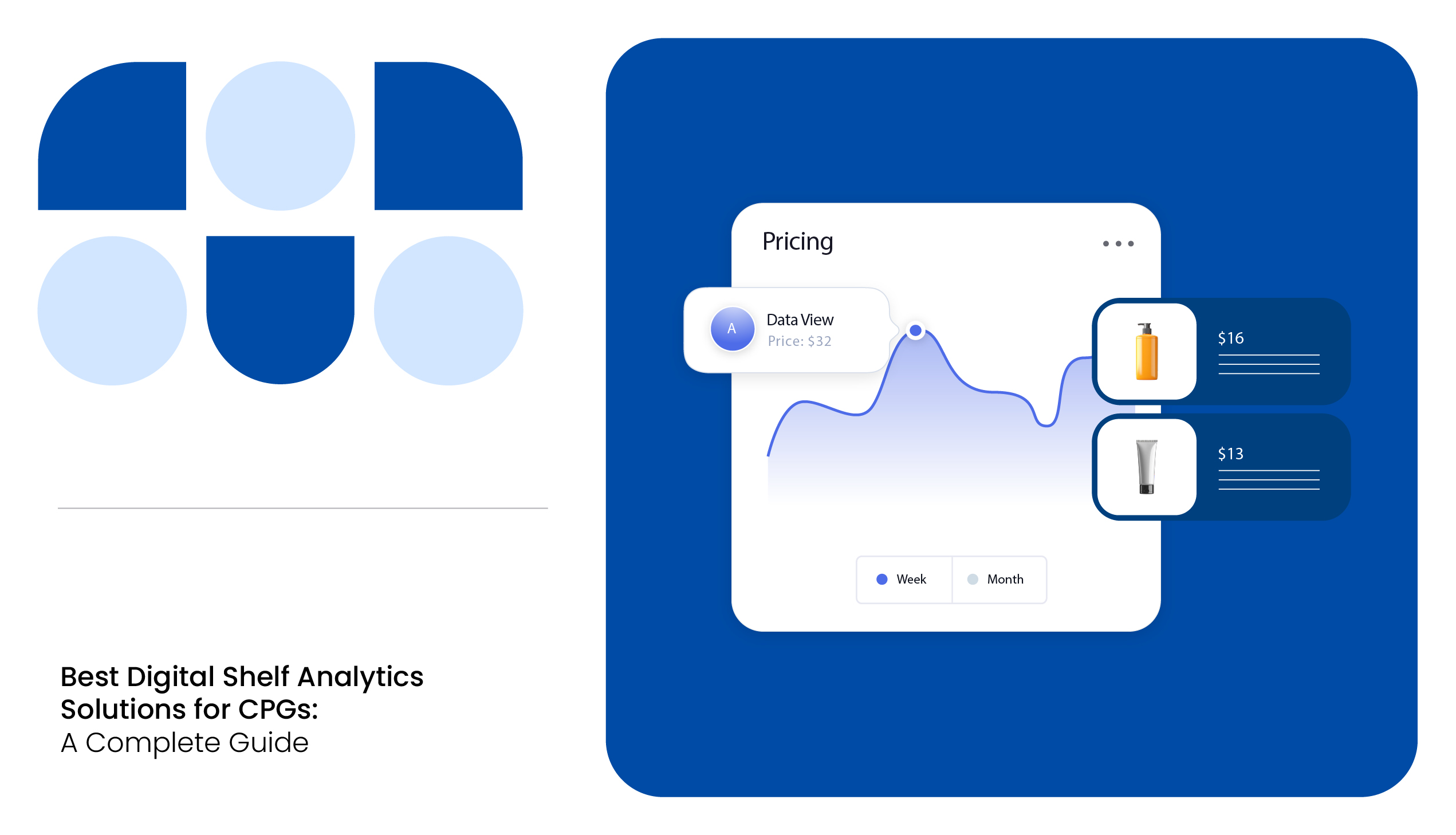Imagine trying to run a race without knowing where the finish line is or how fast you’re going. That’s what running an online store is like without e-commerce analytics. You have no clue where you stand or what needs to change.
Why does it matter? According to McKinsey, companies that embrace data-driven decision-making see a 5-6% increase in productivity and profits.
That’s right, data drives intelligent decisions. But wait, e-commerce analytics isn’t just about the numbers!
It gives you the insights you need to make smarter decisions that can increase sales, improve customer experience, and streamline operations. It is key to uncovering and utilizing data to understand what’s working for your online store, what isn’t, and what you should do next to grow.
Let’s dig into how it works and why it is important for your business.
What Is E-Commerce Analytics?
E-commerce analytics is the process of collecting, analyzing, and interpreting data from your online store to improve your decision-making, marketing strategies, and customer experience.
At a basic level, analytics for e-commerce is about tracking the metrics that matter. These can include everything from website traffic to customer demographics, product performance, and even detailed insights into the consumer buying journey. The more granular your data, the better you can tailor your strategies to your customers’ needs.
Here’s how it works: When customers visit your website, they take various actions. They might browse a product page, add items to their cart, or leave your site without making a purchase. Each action is recorded as data, which, when analyzed, can reveal patterns about how your customers are interacting with your store.
That’s what e-commerce analytics does for you: it turns raw data into actionable insights.
READ MORE| What is Digital Shelf Optimization? Check out From Data to Decisions: Digital Shelf Optimization Explained to learn more.
Why Is E-Commerce Analytics Important?
E-commerce analytics is more than just a tracking tool. It’s a powerful asset that can drastically improve your business performance across the board. Here’s why it’s crucial:
Improved Decision-Making
When you use digital commerce analytics, you’re not guessing about what your customers want or how well your marketing campaigns are performing; you’re making informed decisions based on facts.
Whether you’re adjusting your pricing strategy, optimizing your website, or tweaking your ad campaigns, analytics ensures you’re always moving in the right direction.
For instance, if you see that a particular product is getting a lot of views but few purchases, you’ll know it’s time to rework the product description or adjust the price.
Or, if you notice a high bounce rate on your checkout page, you can dig into online store analytics to find out if there’s a usability issue or if your customers are abandoning their carts for another reason.

In Episode 14 of our Digital Shelf Insider Podcast, Lauren Livak Gilbert, Executive Director at The Digital Shelf Institute, talks in detail about the need for brands to invest in data integration, optimize content strategies for new AI-driven search experiences, and adapt to shifting consumer behaviors. Listen to the full episode here:
Optimizing Marketing Spend
One of the most significant advantages of e-commerce analytics is how it helps optimize your marketing spend.
Marketing is often one of the largest costs for any online store, and you need to ensure you’re investing in channels that bring in the highest returns. Analytics can help you track which marketing efforts are working and which aren’t.
For example, let’s say you’re running ads on Facebook, Google, and Instagram. Analytics will tell you which platform is driving the most conversions and where your marketing dollars are being best spent. This data allows you to shift your budget to the most effective channels, maximizing your return on investment (ROI).
Enhanced Customer Experience
Personalization is key to customer retention, and analytics is the tool that allows you to master the art of creating a tailored shopping experience.
By tracking customer behavior on your website, such as the products they view, the searches they make, and the pages they spend time on, you can deliver personalized recommendations, discounts, or more relevant content.
In fact, 80% of consumers are more likely to make a purchase when brands offer personalized experiences. With e-commerce analytics, you can identify customer preferences and offer tailored product suggestions, personalized promotions, and an overall experience that feels more connected and valuable.
With MetricsCart’s thematic review analysis and customer sentiment analysis, you can gain data-driven insights into what customers expect and fine-tune your strategy for success.
Staying Competitive
The digital marketplace is increasingly competitive, and to stay ahead, you need to know more than just what’s happening within your business; you need to know what’s happening across your industry.
E-commerce analytics helps you track competitor trends, understand customer preferences, and stay ahead of market shifts.
For example, if you see a spike in searches for a specific product category, this could indicate a growing trend. By leveraging digital shelf analytics, you can respond quickly, adjust your product offerings, and capitalize on emerging trends before your competitors do.

Analytics vs. Metrics vs. KPIs
Before we move ahead, let’s break down the difference between three key terms: analytics, metrics, and KPIs. While these are often used interchangeably, they serve different purposes in understanding your business data.

Key Areas to Use E-Commerce Analytics
Let’s take a closer look at the key areas where analytics in e-commerce can drive the most value:
Website Performance Optimization
Analytics allows you to monitor how your website is performing, from load times to navigation flows. For example, if your site’s load time is slow, analytics will show you how this is impacting customer behavior, possibly increasing your bounce rate and lowering conversions.
By identifying problem areas on your site and optimizing them based on real-time data, you can reduce friction, improve the customer experience, and increase conversion rates. Smooth website performance is essential for keeping visitors engaged and turning them into customers.
Customer Acquisition and Retention
Tracking customer acquisition is crucial for understanding which marketing channels are bringing in the highest-quality traffic.
Digital commerce analytics can help you track customer acquisition costs (CAC) and return on ad spend (ROAS) and identify which campaigns convert browsers into customers.
E-commerce analytics also helps with retention. By tracking metrics like customer lifetime value (CLV), repeat purchase rate, and churn rate, you can identify ways to keep your customers coming back, which is far more cost-effective than constantly acquiring new ones.
Conversion Rate Optimization
One of the most important metrics in e-commerce is your conversion rate; the percentage of visitors who make a purchase.
Analytics helps you understand where visitors are dropping off in the buying process. Maybe they’re adding items to their cart but not checking out, or perhaps they’re bouncing from product pages.
By identifying and fixing these points of friction, you can increase conversions. It also helps you A/B test different variations of your product pages, checkout process, and call-to-action buttons to find the most effective combinations for driving sales.
Inventory and Demand Forecasting
Accurate demand forecasting is critical for managing inventory and ensuring you’re always stocked with what your customers want. Analytics helps you track product performance, predict seasonal trends, and adjust your stock levels accordingly.
For instance, if you know certain products have higher sales in winter, analytics will help you plan and order stock ahead of time. This enables you to avoid stockouts, reduce excess inventory, and improve cash flow by only ordering what you need.
READ MORE| Planning your stock is crucial for e-commerce success! Check out Benefits of Monitoring Out of Stock in E-Commerce.
Sales and Product Performance
Tracking which products perform well and which don’t gives you insights into what’s resonating with your customers. E-commerce analytics helps you monitor sales trends over time, identify your best-selling products, and pinpoint underperforming items.
If you notice a particular product isn’t selling as expected, you can adjust your marketing efforts, promotions, or pricing strategy. Analytics helps you optimize your product offerings to maximize sales and profitability.
Pricing Strategy
E-commerce analytics plays a crucial role in optimizing your pricing strategy. By tracking competitor pricing, you can see how your products compare in the market and adjust your prices accordingly to remain competitive.
Additionally, analytics can help you understand your customers’ price sensitivity by analyzing their purchasing behavior. For example, a small price drop can significantly increase conversions, or customers may be willing to pay more for premium versions of a product.
With pricing intelligence and analytics tools, you can make data-driven decisions that strike the right balance between competitiveness and profitability.
Content Optimization
E-commerce analytics gives you a detailed look at how your product content is performing across multiple platforms. By tracking product content KPIs like click-through rates (CTR), engagement, and conversion rates, you can assess whether your titles, descriptions, and images are resonating with customers.
For example, suppose a particular product image has a low CTR. In that case, it might indicate that it’s not appealing to potential buyers, or if a product description isn’t converting, it might be too vague or lacking essential details.
Analytics enables you to continually improve and optimize your product listings, making them more appealing, easier to understand, and more likely to convert visitors into buyers. It also helps with SEO, ensuring that your content is optimized for search engines, driving more organic traffic to your site.
E-Commerce Analytics with MetricsCart
MetricsCart is a powerful digital shelf analytics tool that turns raw e-commerce data into actionable insights, helping you optimize pricing, inventory, and product performance.
It tracks pricing, inventory levels, search rankings, and content compliance across multiple platforms, enabling you to stay dynamic and competitive. It also monitors MAP violations and customer feedback, ensuring your pricing integrity and aligning your offerings with customer expectations.
By transforming data into clear insights, MetricsCart offers real-time analytics for e-commerce that helps you make informed decisions, enhance your competitive positioning, and drive growth across online marketplaces.
Final Notes
A Gartner report predicts that by 2026, 65% of B2B sales organizations will make data-driven decisions.
If you’re not using e-commerce analytics to guide your strategies, you’re already behind!
The beauty of e-commerce analytics is that it doesn’t just tell you what’s happening, but why it’s happening, giving you the power to make smarter decisions faster.
It’s about using insights to fine-tune your pricing, improve customer experience, and stay ahead of the competition.
So, the real question is: Are you ready to make data your competitive advantage? With MetricsCart, turn data into insights and actions to make smarter, faster decisions that fuel growth.
Don’t just track data; use it to lead the market. Let’s get started.
Get Ahead and Stay Ahead. Unlock E-Commerce Success Now!
FAQs
E-commerce analytics involves tracking and analyzing data from your online store to optimize performance, increase sales, and enhance customer experience.
An e-commerce analyst tracks key metrics, analyzes data trends, and provides actionable insights that help businesses optimize marketing, sales, and customer retention strategies.
E-commerce analytics is essential for data-driven decision-making. It helps businesses improve customer experiences, optimize marketing spend, increase conversions, and drive revenue growth.
Data analytics in e-commerce helps businesses understand their customers’ behavior, track product performance, optimize their sales funnel, and ultimately improve their bottom line.
Analytics tools collect and analyze data to provide actionable insights. These tools help businesses track key metrics, improve strategies, and make informed decisions that drive growth.







